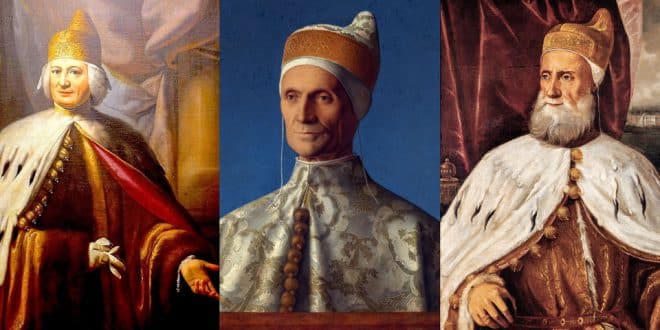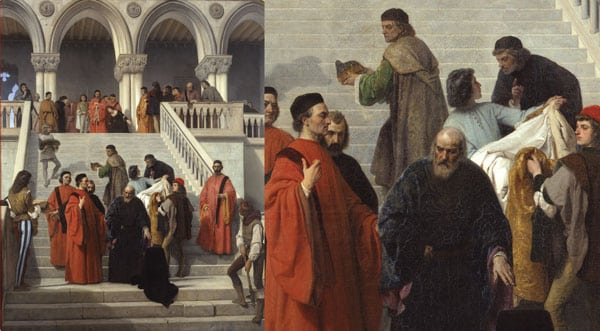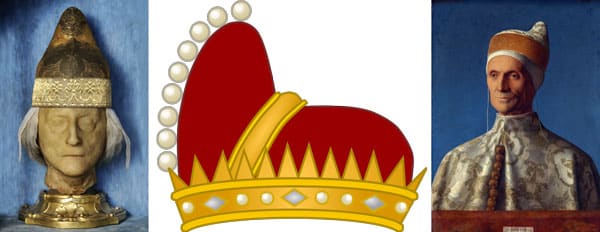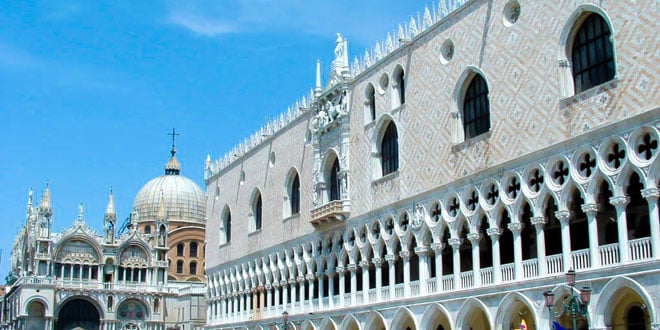Travelers arriving in Venice (Venezia) are enveloped by the desire to immerse themselves in the mysterious atmosphere of this ancient and somewhat magical city. Its centuries-old history is full of mysteries and imbued with a special spirit of aristocracy. In this regard, the stories about the Venetian doges, the rulers of the Republic who ensured greatness, prosperity, and fame for their city-state, are particularly fascinating.
The doge was the head of the Most Serene Republic of Venice (Serenissima Repubblica di Venezia). The title itself originated from the Latin word “dux,” meaning “leader” or “ruler” in English. This honorary state position was elective and lasted for 1100 years. During this time, the Republic of Saint Mark was ruled by 120 doges. You can find the complete list of Venetian doges on a dedicated page on Wikipedia.
Page Contents
Formation and Development of the Doges’ Institution
Legend has it that the first Venetian doge was Paolo Lucio Anafesto (Paolo Lucio Anafesto), but there is no documentary evidence to support this fact.
The approximate start date of his reign is considered to be 697 AD. At that time, Venice was embroiled in internal political conflicts caused by constant conflicts between influential local clans. It was necessary to unite the interests of the elite and direct their forces to combat the external threat coming from the Lombards and Slavs.
The appointment of Paolo Lucio Anafesto occurred after a gathering of the inhabitants of the Venetian Lagoon (Laguna di Venezia), organized at the initiative of the patriarch from the nearby city of Grado (Grado), and was approved by the Byzantine ruler.
Initially, the doges, endowed with unlimited power in political, military, and religious matters, were vassals of the Eastern Roman Empire. This situation persisted during the early Middle Ages and was explained by the fact that Venice was under the jurisdiction of Byzantium.
Afterward, the position of the head of the city-state underwent significant transformations and became more formal. By the 11th century, when the Republic of Saint Mark acquired autonomy and significant influence on the political map of the world, the figure of the doge no longer held the same importance. Over time, the management of financial and military affairs was carried out by elected deputies of the Great Council (Maggior Consiglio) – the main organ of state power, while legislative functions and many political matters fell on the shoulders of members of the Senate.
Read also about the Saint Mark’s Basilica.
How Were the Doges of Venice Chosen and Who Could Be Elected?
Only a representative of a wealthy and influential family, with years of successful experience in public service, could become the holder of this high title. Candidates were usually individuals of respectable age who had demonstrated themselves as skilled diplomats and wise military leaders.
Despite attempts to establish a monarchy in Venice, which would imply hereditary transfer of power, the principle of an elective ruler of the city-state was maintained. The complex procedure for appointing a doge took its final form in the 13th century. In 1268, rules were established, including 11 stages of voting, to ensure the interests of all the elites were taken into account. The electoral system remained unchanged until the final days of the Venetian Republic.
Characteristics of the Doge’s Position
The position of the Venetian doge entailed numerous limitations, including the prohibition of personal enrichment and any privileges for the ruler’s family members. Furthermore, the wealth of the head of the Venetian Republic often served as a source of financing lavish city celebrations, ceremonial processions, military campaigns, and other state events.
Neither the doge nor his relatives could own property located in another country. His children were not allowed to marry foreigners, and his spouse was not permitted to engage in commercial activities or accept gifts from overseas merchants.
The life of the doge was constantly monitored by members of the Council of Ten (Consiglio dei Dieci), who gathered compromising information through informants and trusted individuals. Cases of embezzlement of state property could be prosecuted during the doge’s lifetime and even after his death.
Special attention was given to upholding the rule of law. It was through the work of secret judges and punishers that in 1355, the 55th Venetian doge, Marin Faliero, was accused of state treason and beheaded. He had attempted to monopolize supreme power through a state coup. This tragic episode from the history of the Venetian Republic was immortalized five centuries later in 1867 by the Italian painter Francesco Hayez in his artwork “The Last Moments of Doge Marin Faliero on the Stairs of the Piombi.”
Ceremonial Duties of the Doges
The Doge has always been the central figure in all the processions and celebrations held in Venice. Since the 12th century, a tradition emerged of performing the ceremony known as the “Marriage with the Adriatic Sea,” which persisted until the fall of the Republic of St. Mark.
The celebration took place annually, coinciding with the religious holiday of the Ascension of the Lord and was linked to the legendary events when the 26th ruler of Venice, Pietro II Orseolo, triumphantly conquered the northwest territories of the Balkan Peninsula.
According to tradition, the Doge would board his magnificent 30-meter golden galley called the “bucintoro” and offer prayers to the water element, seeking its benevolence for the local inhabitants. As a symbol of Venice’s power, grandeur, and unbreakable bond with the Adriatic, the Doge would cast his ring into the sea.
Symbol of Power
The main symbol of authority for the Venetian Doge was a special headgear known as the Corno Ducale, which resembled a hat with a horn.
This distinctive cap was traditionally made of heavy brocade with golden threads, sometimes adorned with luxurious velvet. The Doge’s headgear was often embellished with an array of precious gemstones, including rubies, emeralds, diamonds, and pearls. The ruler of Venice received the hat during the inauguration ceremony and was obligated to always wear this symbol of power. For formal occasions, a more elaborate version of the headgear was used, while in ordinary situations, the Doge would wear a simpler velvet cap.
Every year, on Easter Sunday, the abbess of the San Zaccaria convent presented the city’s ruler with a new headgear crafted by the nuns.
The Doge’s Palace
The residence of the ruler was the Doge’s Palace (Palazzo Ducale). Within its walls, meetings of the Great Council, the Senate, the Supreme Court, and even the Secret Inquisition took place. The Doge had access to 11 rooms, most of which served as reception rooms.
The magnificent building of the current palace, adorning the Piazza San Marco, is designed in the Gothic style. Its construction began in the 14th-15th centuries on the site where the first Doge’s residence, dating back to 810, no longer stands. Today, the palazzo functions as a museum, and its lavish interiors attract millions of art and history enthusiasts every year.
Read also about the most beautiful palaces in Venice
Interesting Facts about Venetian Doges
- The Venetian Doges were the elected rulers of the Venetian Republic from 697 to 1797, spanning over 1,000 years of Venetian history. Their reign witnessed the growth and prosperity of Venice as a significant maritime power.
- The Doge’s Palace, located in Venice, was the seat of the Doges and a symbol of their authority. With its stunning architecture and ornate decorations, this impressive Gothic palace was the center of political and administrative activities.
- One notable Doge was Enrico Dandolo, who reigned from 1192 to 1205. He led Venice during the Fourth Crusade and played a key role in capturing Constantinople in 1204, significantly expanding Venetian influence and wealth.
- The election of the Doge involved a complex process. The Great Council chose eligible candidates, and the final selection was made through a series of secret ballots. This system aimed to ensure a fair and balanced representation of power in the Venetian government.
- The Venetian Doges were known for their patronage of the arts and culture. They supported renowned artists, architects, and musicians, creating magnificent works that enriched the cultural heritage of Venice, including masterpieces by Titian, Tintoretto, and Veronese.
- The Council of Ten, a powerful governing body in the Venetian Republic, served as a surveillance and intelligence agency. It was responsible for maintaining internal security, conducting investigations, and ensuring the loyalty of the Venetian population, often through secret and ruthless methods.
- The decline of the Venetian Republic and the Doges came with the French conquest of Venice in 1797. Napoleon Bonaparte’s forces occupied the city, marking the end of the long-standing Venetian Republic and its unique system of government under the Doges.
 Italy for me From Italy with love
Italy for me From Italy with love






